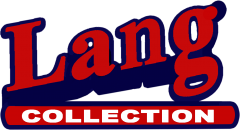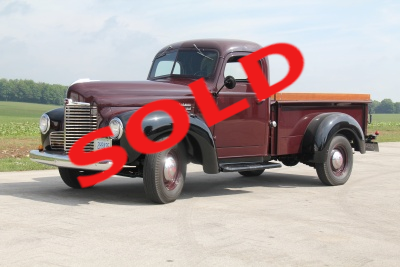*This truck has been sold*
1948 INTERNATIONAL KB2 NO 14
¾ Ton International Truck
Flat 8
Complete restoration to 1000 points
Models
The K models progress from 1 to 14 based upon the load capacity (K1 = half ton, K2 = 3/4 ton, K3 = 1 ton, etc.).
There are no K-9 or K-13 model trucks.
Light duty
Few differences exist between K-1 and K-2 models as they share most of their mechanical and chassis components. The rear axle in these two models is supported by a single roller bearing. Their differences in load rating are due to the K-2's stronger suspension.
The K-3 has a heavier frame, larger brakes, and rear axles supported by two roller bearings on a free floating rear end.
The Mechanization of Farms
Farming always has been and will always be hard work. Mechanization has just changed the scale of that labor. Now farmers can accomplish much more with that industry. From McCormick and Hussey reapers (1834), John Deere’s steel plow (1837), through Massey Ferguson’s first mechanical threshers and the adoption of large steam engines to run the threshers, farmers were able to produce more with less and less manpower.
In 1891, Massey merged with A. Harris and Co (Massey-Harris Limited - Toronto) becoming the largest agricultural equipment manufacturer in the British Empire. They made threshing machines, reapers, plows and other products like safety bicycles. Large agricultural steam engines were also made in Canada by companies such as Sawyer-Massey (based in Hamilton, ON) and the Robert Bell Engine made in Seaforth, ON.
But perhaps the biggest change for family farms was the adoption of small tractors to individual farms starting in the 1920’s. “According to Olmstead and Rhode (2008), early tractors included the Bull (1913) the first small agile tractor, the Fordson (1917) the first mass produced tractor, and the Farmall (International Harvester) in 1924 the first general purpose tractor capable of cultivating row crops such as corn and cotton. The Farmall was also the first gasoline-powered tractor that incorporated a power takeoff (PTO).” Farmall was the largest selling row tractor in North America between 1924 and 1963.
The problem Ford had with his tractor during these early years was with Ford himself. He designed it to be a mechanical horse so it could only do what a horse could do. Farmall’s PTO, on the other hand, could be hooked up to and power a range of other farm equipment such as a mower, reaper, or baler. Early Ford’s could not. Massey Harris (Toronto) produced the first self- propelled combine harvester during the late `30’s and one of the first four wheel tractors.
The pace of rural mechanization quickened after WWII. The first tractor with a live PTO (operating separate from the moving tractor) was the Cockshutt Model 30 (LPTO) manufactured in Brantford ON in 1946. Another sign of this increased rural mechanization was the use of pick-up trucks such as the Lang Collection’s superb 1948 International KB2. Even before a farmer could afford a tractor, he could use the convenience and versatility of the truck to work the farm and still take the family to the near-by towns for the necessaries.
One local farmer reported that his Father got their first tractor, an Allis Chalmers WD, in 1955. His Dad remembered that one man with a horse could plow an acre a day… but with a tractor he could plow five acres! Thus was born the economies of scale paradox we face today.
One interesting note on the modernization of rural Canada was the coming of phone and electrical service to farms in this area before WWII. Given a choice, the Bruce County farmer generally chose the installation of a phone before electricity. They knew how to operate their farms without electricity, been doing it for generations, but a phone, on an isolated farmstead in winter, could mean the difference between life and death.

